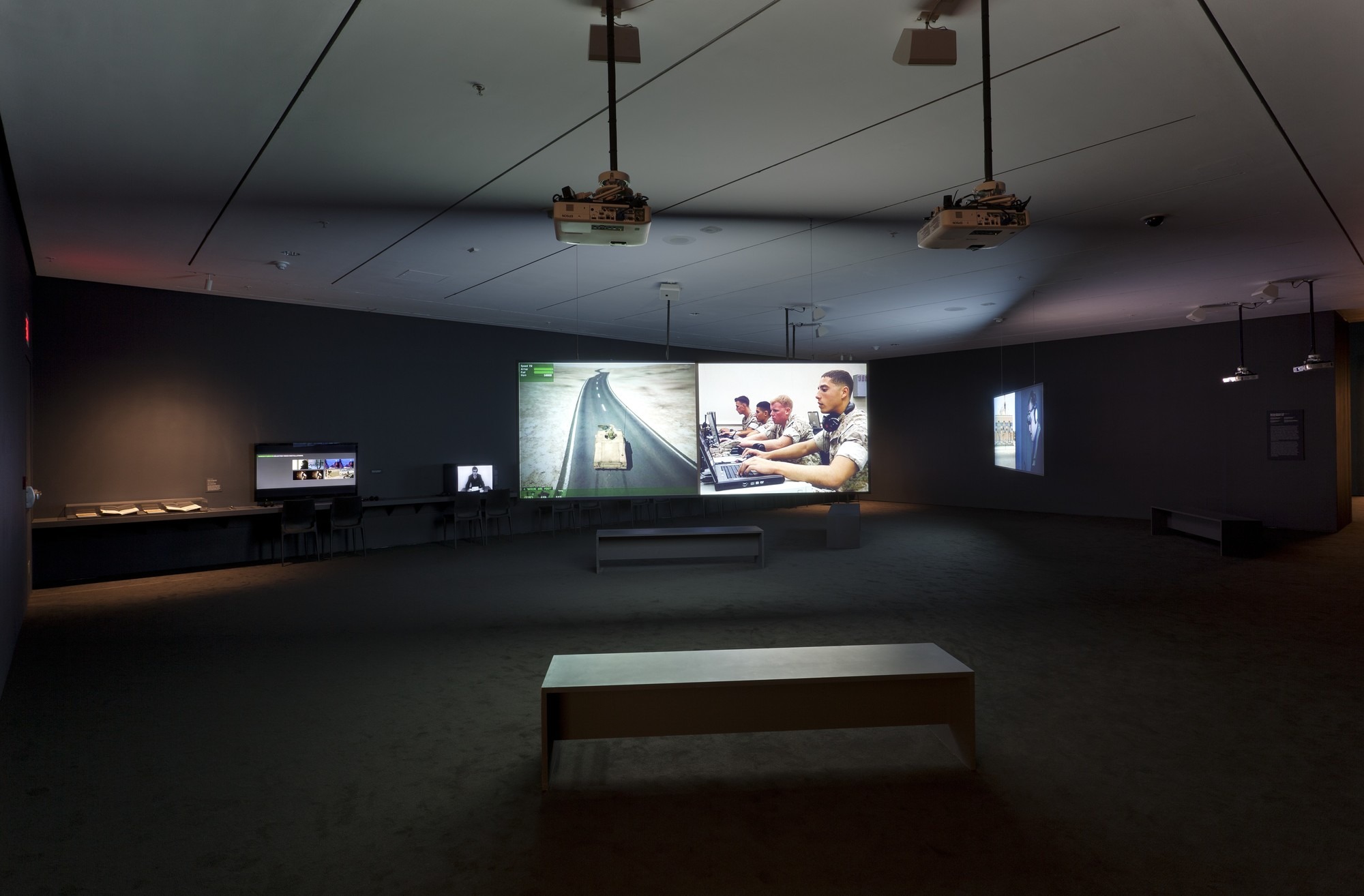Harun Farocki
Images of War (at a Distance)
29 Jun 2011 - 02 Jan 2012

Installation view of the exhibition, "Harun Farocki: Images of War (at a Distance)"
June 29, 2011–January 2, 2012. IN2162.2. Photograph by Jonathan Muzikar.
June 29, 2011–January 2, 2012. IN2162.2. Photograph by Jonathan Muzikar.
Harun Farocki: Images of War (at a Distance) marks the first comprehensive solo exhibition of Berlin-based artist Harun Farocki (b. 1944, German-annexed Czechoslovakia) in a U.S. museum, and features the U.S. premiere of Serious Games I–IV (2009–10), a four–part video installation at the center of the exhibition. The exhibition reflects a recent large-scale acquisition—realized as a joint effort by MoMA’s departments of Media and Performance Art and Film—of 36 artworks, a body of work spanning four decades and including nearly all of Farocki’s videos, video installations, and films in video format.
Galvanized by the international student protest movement of the late 1960s, Farocki has developed an experimental documentary style, integrating his own material with footage appropriated from a range of sources, including mass media, surveillance, and political propaganda. Serious Games I–IV (2009–10), which is comprised of four distinct video installations—I: Watson is Down (2010), II: Three Dead (2010), III: Immersion (2009), and IV: A Sun with No Shadow (2010)—positions video game technology within the context of the military, where it originated. The work juxtaposes real-life wartime exercises with virtual reenactments in order to examine the fundamental links between technology, politics, and violence. Other works on view include the early agit-prop film Inextinguishable Fire (1969) and Videograms of a Revolution (1992), a collaboration with Andrej Uijca. The exhibition also includes Farocki’s most recent work, The Silver and the Cross (2010). Some 32 works are presented at three interactive viewing stations, providing a comprehensive overview of Farocki's practice.
In the adjoining Projects Gallery, I Thought I Was Seeing Convicts (2000) and the trilogy Eye/Machine I-III (2001–03), are on view from June 29 through October 17, 2011. I Thought I Was Seeing Convicts draws connections between the role of surveillance in everyday consumer culture and in prison life, directing viewers’ attention to the fatal shooting of an unarmed prisoner by a guard at a maximum-security penitentiary in 1989, an event that was caught on camera. In Eye/Machine I-III, Farocki collects images from military and industrial surveillance devices to explore the increasingly complex relationship between humans and machines.
A selection of publications featuring texts by or about the artist will also be available in the exhibition gallery, presenting the various dialogues that have taken shape around Farocki’s work, as well as his indelible impact on film criticism and theory.
Galvanized by the international student protest movement of the late 1960s, Farocki has developed an experimental documentary style, integrating his own material with footage appropriated from a range of sources, including mass media, surveillance, and political propaganda. Serious Games I–IV (2009–10), which is comprised of four distinct video installations—I: Watson is Down (2010), II: Three Dead (2010), III: Immersion (2009), and IV: A Sun with No Shadow (2010)—positions video game technology within the context of the military, where it originated. The work juxtaposes real-life wartime exercises with virtual reenactments in order to examine the fundamental links between technology, politics, and violence. Other works on view include the early agit-prop film Inextinguishable Fire (1969) and Videograms of a Revolution (1992), a collaboration with Andrej Uijca. The exhibition also includes Farocki’s most recent work, The Silver and the Cross (2010). Some 32 works are presented at three interactive viewing stations, providing a comprehensive overview of Farocki's practice.
In the adjoining Projects Gallery, I Thought I Was Seeing Convicts (2000) and the trilogy Eye/Machine I-III (2001–03), are on view from June 29 through October 17, 2011. I Thought I Was Seeing Convicts draws connections between the role of surveillance in everyday consumer culture and in prison life, directing viewers’ attention to the fatal shooting of an unarmed prisoner by a guard at a maximum-security penitentiary in 1989, an event that was caught on camera. In Eye/Machine I-III, Farocki collects images from military and industrial surveillance devices to explore the increasingly complex relationship between humans and machines.
A selection of publications featuring texts by or about the artist will also be available in the exhibition gallery, presenting the various dialogues that have taken shape around Farocki’s work, as well as his indelible impact on film criticism and theory.
